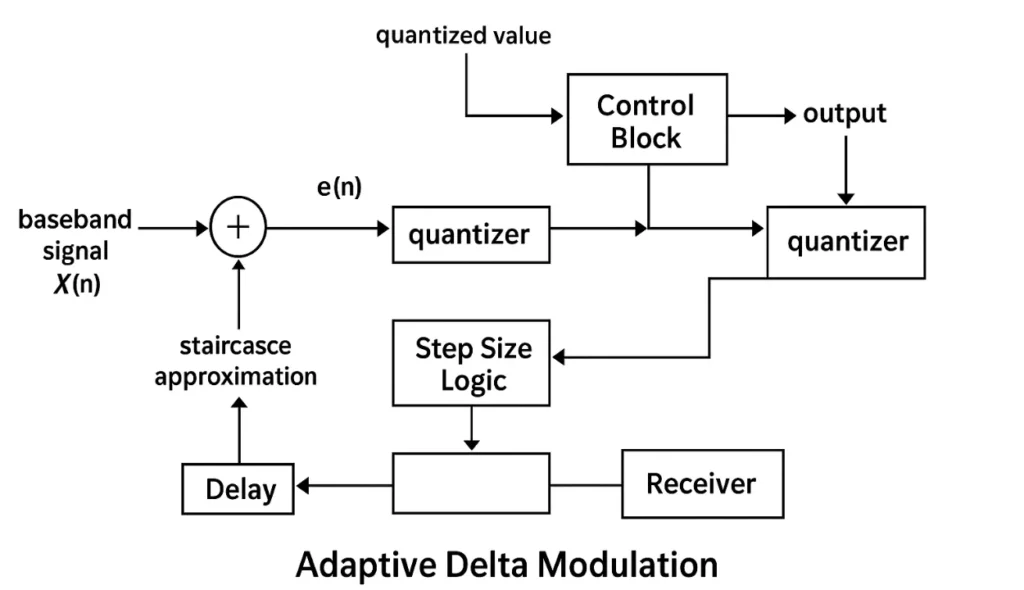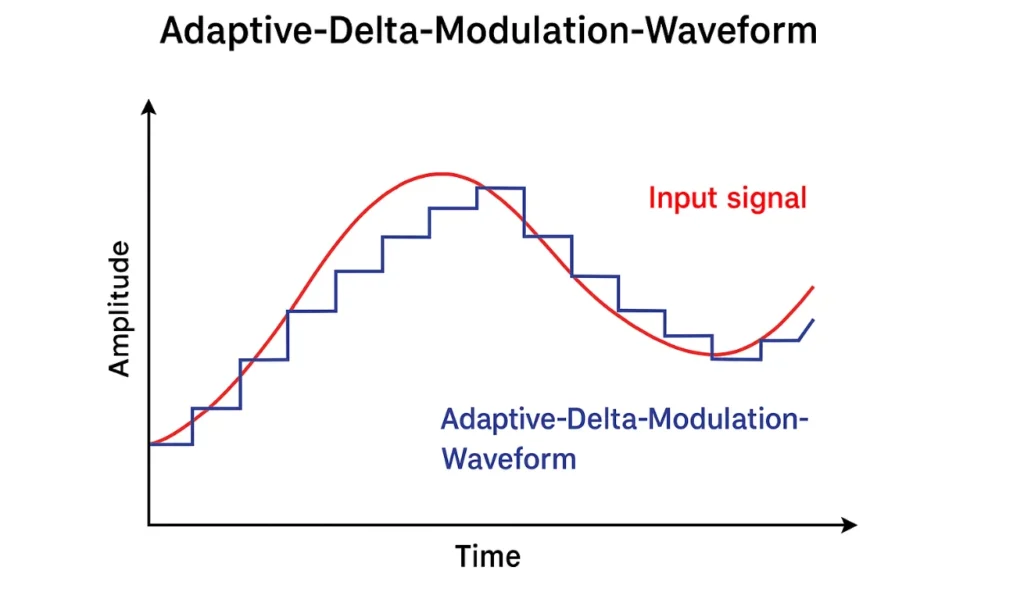Introduction
In modern communication systems, the need to transmit signals across long distances has led to advancements in technology and an increase in demand for efficient methods. The properties of a high-frequency signal, such as amplitude and phase, can be changed during the process of modulation to match a low-frequency baseband signal. Over time, digital techniques were introduced, making digital-to-analog and analog-to-digital conversion of sampled signals more precise.
Many methods like pulse code modulation, differential pulse code modulation, delta modulation, and adaptive delta modulation became popular in digital signal processing. This article will look at how adaptive modulation has increased efficiency and how we can take a closer look at processing in digital communication. So, let us explore why this approach is vital in the world of analog and digital integration.
What is Adaptive Delta Modulation?
The refined form of delta modulation was introduced as a method to solve issues like granular noise, slope overload, and other errors caused in earlier systems. In this method, the step size is not fixed but variable, adjusting with the input signal to provide better accuracy. Unlike the similar basic delta modulation, the adaptive version changes its value dynamically. This approach improves efficiency in modulation by adapting to the nature of the signal. Thus, adaptive delta modulation stands as a stronger method for handling diverse communication needs.
Block Diagram and Working
The transmitter circuit uses a summer, quantizer, delay, and logic to manage step size control. A baseband signal like X(nTs) is given as input, while the feedback integrator creates a staircase approximation of the previous sample. The difference marked as e(nTs) becomes the error passed into the quantizer, producing a quantized value.
Inside the block, the step size is adjusted for the next approximation, depending on whether the quantized value is high or low, and the output is forwarded. At the receiver end, demodulation occurs in two parts, where the first stage uses a logic block for step size based on the current bit. This ensures the system can adapt by checking both the present and the earlier input.
In the second stage, the accumulator circuit recreates the waveform of the staircase signal. It is then applied to a low-pass filter, which smooths the waveform and restores the original signal. With this process, the receiver successfully tracks the transmitter and maintains the clarity of the transmitted data. You can also read about local oscillator.

Theory Behind Adaptive Delta Modulation
In adaptive delta modulation, the step size of the staircase signal is not fixed but changes with the input. The difference between the present sample and the previous approximation is calculated, and this error is then quantized. If the sample is smaller, the quantizer produces a low value; otherwise, the output is high.
The one-bit quantizer sends its output to the logic circuit, where control of the step size is decided. If the quantized output is high, the step is doubled for the next sample; if it is low, the step is reduced. This system ensures that the adaptive delta modulation waveform follows the signal accurately while maintaining efficiency in modulation. You can also read about VI characteristics of SCR.

Differences between Delta Modulation and Adaptive Delta Modulation
| Differences | Delta Modulation | Adaptive Delta Modulation |
|---|---|---|
| Step size | The step size is fixed for the whole signal. | The step size varies with the input signal. |
| Errors | Slope overload, granular noise, and other errors are present. | These are minimized or solved in adaptive modulation. |
| Range | Has a limited dynamic range. | Provides a wider range for better performance. |
| Bandwidth | Does not use bandwidth very effectively. | Utilizes bandwidth effectively to improve efficiency. |
| Performance | These differences are listed as challenges in delta modulation. | Adaptive delta modulation improves and optimizes the modulation process. |
Key Advantages of Adaptive Delta Modulation
Adaptive delta modulation effectively decreases slope error and granular problems that are present in standard modulation.
During demodulation, a low-pass filter removes quantized noise, giving a better signal-to-noise ratio.
In the presence of bit errors, it provides robust performance, reducing the need for detection and correction circuits in radio design.
The dynamic range is large, as the variable step size covers wider values without causing overload.
This makes the system more reliable, with improved performance across different signal conditions.
Practical Applications of Adaptive Delta Modulation
Adaptive delta modulation is used in systems that need improved wireless voice quality and a higher speed of bit transfer.
In television (TV) signal transmission, this process of modulation is applied for clear data flow.
It plays a role in voice coding and audio detection for digital communication.
NASA uses it as a standard in mission control and spacecraft communication with shuttle links.
Motorola’s SECURENET digital radio products rely on 12 kbps adaptive modulation.
The military and US Army forces use 16 kbit/sec and 32 kbit/sec rates to conserve bandwidth over tactical links.
The US Air Force applies it for voice quality at 32 bits per second with effective control.
In Bluetooth services, it helps to encode voice signals for efficient communication.
The HC55516 decoder is used in arcade games like Sinistar, Smash TV, and pinball machines such as Gorgar or space titles, to play pre-recorded sounds.
Adaptive delta modulation is also called continuously variable slope delta modulation, demonstrating its flexible method.
These applications are listed to highlight their wide role in digital modulation systems.
Conclusion
Adaptive delta modulation has proven to be a powerful technique that balances simplicity with efficiency in modern communication systems. By adapting the step size to the nature of the signal, it successfully reduces slope overload, granular noise, and other errors. Its ability to provide a wide dynamic range makes it reliable across different conditions. From military communication to wireless voice transmission, television, and even arcade games, its applications show remarkable versatility. The method not only conserves bandwidth but also ensures a better signal-to-noise ratio and robust performance. Overall, adaptive delta modulation stands as an essential approach in bridging analog and digital communication effectively.
